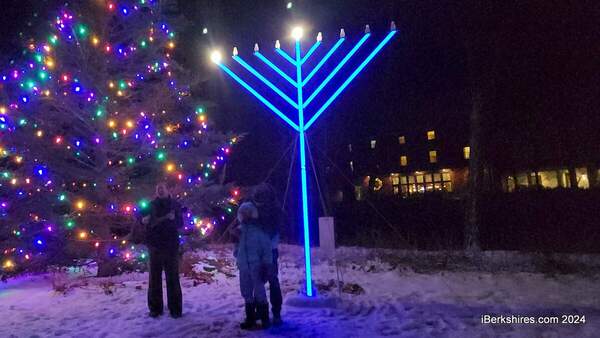


Mount Greylock Decides to Reduce Building Debt Assessment in Year One
WILLIAMSTOWN, Mass. — The Mount Greylock School Committee has decided to pay less on the school building project bond in the first year and forego savings that would not be realized until years down the road.
The question of whether to more aggressively pay down the principal on a $30 million bond has been discussed since the school district's two member towns passed a debt exclusion for the project in March.
The School Committee on April 5 favored the more aggressive debt repayment, which would mean a larger hit on local property tax bills in the first year. But it agreed to revisit the issue after more information was available.
On Tuesday, committee member Richard Cohen came equipped with research he had done in the interim and a series of charts that appeared to show the payback from putting more money down in Year 1 of the 29-year bond would be smaller than some thought, even less when inflation is taken into account and not realized until the final years of the bonding period.
Ultimately, four of the five members in attendance voted to eschew the long-term savings and "ramp up" the capital assessments over the first few years of the project.
At issue was how much the district will assess Williamstown and Lanesborough in Year 1.
Voters will be asked to approve a school district budget at town meeting this spring, and that budget will include a capital assessment on the renovation and addition project at the junior-senior high school.
Under one scenario, the capital assessment would address mostly interest on the bond, which will be floated later this calendar year, and hit the towns with debt service costs of $1.2 million ($362,287 to Lanesborough and $787,830 to Williamstown).
Under a second scenario, the assessment would include more of the principal of the bond and cost the towns $1.8 million ($560,993 to Lanesborough and $1,219,936 to Williamstown).
The latter scenario is the one that the School Committee picked on April 5 and the one that is written into the warrant article for Williamstown's May 17 annual town meeting (Lanesborough's is June 14).
Cohen essentially made two arguments against paying more of the principal in Year 1: the cost savings will not be realized for nearly three decades and district officials told voters in the weeks leading to the debt exclusion vote that the tax impact of the project would grow over time.
"There are people on the Lanesborough Finance Committee who would like this to be a painful moment, so they can use that against the school in the future," Cohen said.
School Committee Chairwoman Carolyn Greene, who ultimately voted against Cohen's motion to not pay as much principal in Year 1, argued that the Finance Committees in both member towns had endorsed the idea of a more aggressive debt payment schedule.
But Cohen countered that the Finance Committees did not have all of the facts when they made those advisory votes.
He agreed that paying more upfront to save money in the end has an "intuitive logic" but argued that the Finance Committees did not consider the full 29-year repayment schedule or look at the ultimate "break-even" point.
That led to an exchange between Cohen and Greene, who asserted the Fin Comms and School Committee did have that information before their votes in late March and early April.
"I'm not sure why you didn't see it," Greene said.
"I didn't just not see it," Cohen said. "I specifically asked for it at our last meeting.
"I don't think the Fin Comms were expecting a 29-year payback period."
The Williamstown Finance Committee held an 11 minute, 30 second discussion about the debt repayment strategies at its March 30 meeting. It did not discuss specifics of the break-even point, but the Fin Comm members did express a preference for saving money over the life of the bond by paying more principal in Year 1.
On the other hand, a review of the tape of the Williamstown Fin Comm makes it clear that the panel was considering a "worst case" number for the debt assessment in FY17 and understood that the final decision rested with the School Committee.
"I think the solution mostly likely is we would have an amendment at Town Meeting to revise that number if a revision is necessary," Williamstown Town Manager Jason Hoch told the Fin Comm.
School Building Committee Co-Chairwoman Paula Consolini, who serves on Williamstown's Fin Comm, attended Tuesday's School Committee meeting and advised the panel to bring the matter back to the Finance Committees before deciding an assessment to bring to the two town meetings.
Consolini said she thought the Finance Committees would be open to listening to Cohen's analysis and would be willing to reconsider their advisory votes.
But Cohen said the School Committee needed to make the best decision for the district, and he and Greene agreed there was no time for another round of Fin Comm meetings and School Committee approval of a revised assessment before the May 17 Williamstown annual town meeting.
Williamstown Selectman Hugh Daley also spoke at Tuesday's meeting for the School Building Committee's finance working group, which developed the bonding scenario numbers.
Daley advocated for the more aggressive debt repayment.
"If we are going to save $250,000 over the life of the project … this is a real opportunity for the School Committee to support the towns, to show real leadership on the cost containment," Daley said.
Daley also said Cohen was putting political considerations ahead of the district's interests.
"My decision is based on what's going to build the most support for the school for the next 50 years," Cohen said.
He pointed to the current discussion in Lanesborough about cutting health care benefits for retirees and said the higher capital assessment from Mount Greylock is being blamed for that move.
"It's this issue that's driving the political discussion in Lanesborough — the idea that they were going to have to make Draconian cuts," Cohen said.
As for the question of whether voters were promised the building project costs would "ramp up" over time, School Building Committee Mark Schiek agreed that notion was discussed with voters in advance of the March votes, but he said it had nothing to do with the question of whether to pay down more of the principal in Year 1.
"When we built a bonding scenario [leading up to the debt exclusion votes], we weren't sure what would happen with interest rates," Schiek said. "Our first pass was to borrow $10 million the first year, $10 million the second year and then close out the project [with a third bond].
"I think the intent here would have to be we looked at the interest rates now, and the bond counsel is telling us we're better off borrowing a large chunk now with a [smaller] cleanup bond later."
In other words, the change has to do with when the bulk of the money is borrowed - not when the principal is paid back, Schiek said.
That said, Schiek said he had no opinion on which way the School Committee decided to go on the principal payment question.
Fellow Lanesoborugh resident and School Committee member Chris Dodig did agree with Cohen's analysis. Although Dodig expressed a preference for looping the towns' Finance Committees back into the conversation, he ultimately seconded Cohen's motion and supported it.
"The plan that is cheaper in the first year is a benefit to current taxpayers," Dodig said. "The plan that has the savings has … savings to future taxpayers. That's what I was getting at at the last meeting. It's a generational thing.
"I think to me it seems reasonable to ask the future generation to pick up a little bit of it. I think if we put this to public … they would overwhelmingly say put the balloon payment on the back end. Don't put it on the front end."
Williamstown residents Steven Miller and Wendy Penner voted with Cohen and Dodig. Williamstown's Gary Fuls and Lanesborough's Sheila Hebert did not attend Tuesday's meeting. Greene, who resides in Williamstown, cast the lone vote in favor of sticking to the debt assessment the School Committee approved on April 5.
In other business on Tuesday, the School Committee heard from a group of district retirees concerned that the district is thinking of raising the retiree contribution for its health care plan, began a discussion of where the superintendent's office will go when the school renovation project is complete and approved a proposal for a June 2017 student white water rafting trip to the Western United States.
Teacher Lynn Jordan explained that she needed the School Committee's approval now to allow families to commit to the trip and, if they choose, begin raising money to defray the cost. She also said that the company that runs such trips offers incentives to student groups who book early. Jordan said she wants to open the trip up to students in grades 9 through 12, and she plans to have 20 to 30 students and two to three chaperones.
The committee also discussed the November election. Four spots will be on the ballot. The terms of Hebert, Fuls and Miller are set to expire. Cohen has announced his intention to step down from the board and his desire to give townspeople time to get their names on the ballot. Nomination papers are available at both town halls and at the Tri-District office at Mount Greylock.
Tags: bonding, MGRHS, MGRHS school project,















